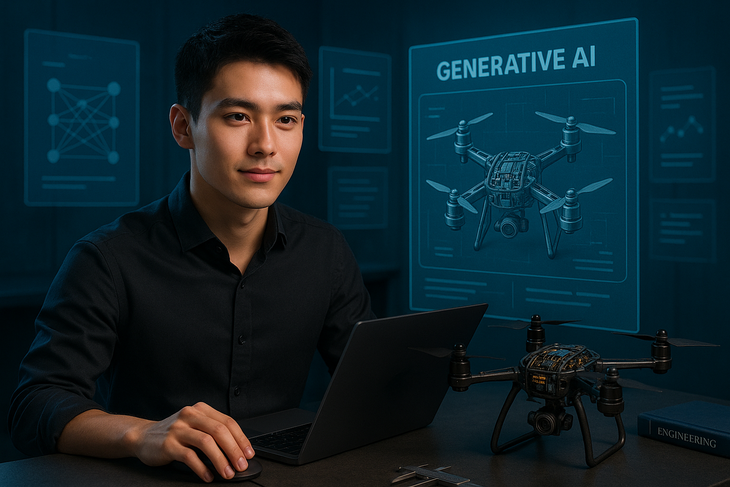
Generative AI is gradually becoming an assistant for design in the field of UI/UX - Illustration of AI
In the past few years, Generative AI has come a long way, not only in the technology field but also deeply penetrated the design industry, especially UI/UX.
From a designer's perspective, it is not just a tool, but a "creative teammate" that speeds up the process, opens up new horizons in performance, personalization and creativity, thereby enhancing the user experience.
Generative AI is Redefining the UI/UX Design Process
Simply put, UI (User Interface) is everything you see and interact with directly on the screen. It includes colors, fonts, layouts, buttons, images... The goal of UI is to create a beautiful, consistent, and easy-to-use interface to attract users.
Meanwhile, UX (User Experience) is the entire feeling, thought and emotion of the user when they interact with the product. UX focuses on making the product useful, easy to find information, efficient and satisfying for the user. And a good product needs both beautiful UI and smooth UX for the best user experience.
Traditionally, UI/UX design processes required a lot of time and effort for repetitive tasks like creating mockups, wireframing, A/B testing, and optimization. Generative AI is changing the game by automating these tasks, freeing up designers to focus on more strategic and creative aspects.
Generative AI can quickly generate hundreds, even thousands, of UI/UX design variations based on input parameters. This ranges from generating different layouts, matching typographies, to suggesting harmonious color palettes. This capability significantly reduces the time from ideation to final product, while allowing designers to experiment with more options in the same amount of time.
One of the biggest challenges in UI/UX is creating personalized experiences. Generative AI, with its ability to analyze massive amounts of user data, can design custom interfaces and interactions for each audience.
For example, an e-commerce application can automatically adjust product layouts, suggest promotions, and even change the interface language based on each customer’s behavior, preferences, and shopping history. This not only increases satisfaction but also boosts conversion rates.
Generative AI doesn’t just replicate what already exists, it can create unique and unexpected design ideas that designers may not have thought of. By combining elements from different sources and applying machine learning algorithms, AI can come up with creative solutions to complex UI/UX problems. This helps break traditional molds and encourage innovation in the industry.
Practical Applications of Generative AI in UI/UX
Rapid Prototyping: AI tools can turn ideas into interactive prototypes in minutes, helping designers and stakeholders visualize and evaluate products visually.
Design analysis and optimization: AI can analyze user behavior data on existing interfaces to identify weaknesses and suggest improvements. It can predict the effectiveness of design changes before they are implemented, thereby analyzing and optimizing the user experience.
Automated and Adaptive Design: Regenerative AI systems can automatically generate a new user interface based on newly provided content or data. Or an interface can automatically adjust its size, color, and layout based on the device, ambient lighting, or even the user's mood. Enhanced personalization of designs based on the user experience.
Supporting users with disabilities: Generative AI can help create more accessible interfaces for users with disabilities, such as generating voice control options, alternative text for images, or useful automatic font size and contrast adjustments.
Challenges and the future
While the potential of generative AI in UI/UX is huge, there are still some challenges to overcome.
The first is to ensure ethical use of AI, avoid potential biases in training data, and maintain a balance between automation and human intervention.
Human creativity remains irreplaceable. AI is a tool to augment, not replace, the role of the designer.
In the future, we can expect deeper integration between generative AI and existing design tools, creating a more robust ecosystem for UI/UX designers. AI will not only be an assistant but also a thinking partner, helping to shape increasingly rich, personalized, and user-friendly digital experiences.
Creativity is not replaced, but accelerated
AI doesn't take designers' jobs, it eliminates the most labor-intensive parts so you have more time to create, experiment, and do what you do best: understand people.
In addition, generative AI can combine seemingly unrelated elements to create completely new designs, ideas that the human mind sometimes finds difficult to reach. This is the factor that explodes unlimited creativity in the industry, breaks all barriers and redefines the concept of modern UI/UX design.
For design students, AI is an opportunity to learn faster, do more, and get closer to real user experiences.
Source: https://tuoitre.vn/ai-tao-sinh-ho-tro-nha-thiet-ke-trong-nganh-ui-ux-20250610111512323.htm


































































































Comment (0)